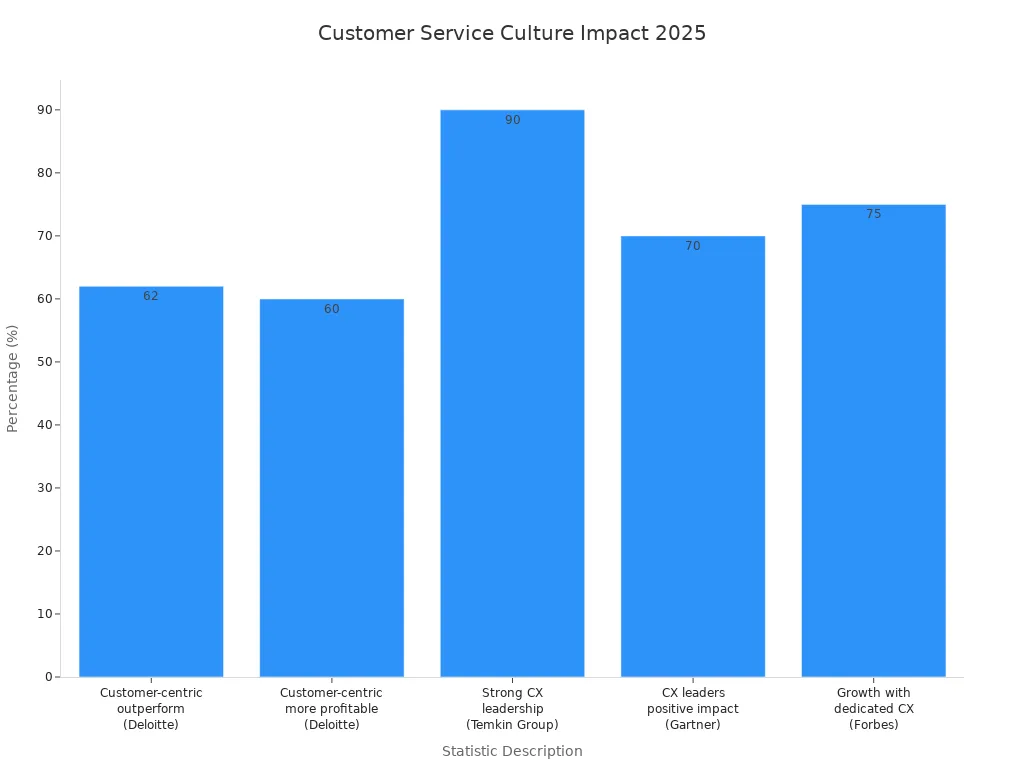Customer service culture examples every leader should know

Customer service culture means how you and your team treat customers every day. The importance of customer service grows in 2025 as companies with strong cultures see better results. You need to focus on both customer-centricity and employee empowerment. This balance leads to higher performance and satisfaction. The table below shows the importance of customer service culture for business success.
| Statistic | Description |
|---|---|
| 62% | Companies with a customer-centric culture outperform their competitors. |
| 60% | Companies with a customer-centric culture are more profitable. |
| 90% | Strong CX leadership leads to higher customer satisfaction rates. |
| 70% | CX leaders see positive impacts from CX initiatives. |
| 75% | Significant growth links to dedicated CX teams led by senior executives. |

Technology and innovation change how you build service culture. You now use Sobot AI, Sobot call center, and omnichannel tools to help your team work smarter. Companies move from reactive to proactive service, focus on relationships, and use customer service culture examples like Sobot to guide their growth.
- Businesses now use:
- Proactive service models to predict customer needs.
- Omnichannel platforms for seamless support.
Customer service culture in 2025

Defining service culture
You shape your company’s service culture by how you treat both customers and employees. In 2025, leaders focus on more than just solving problems. You create an environment where service becomes a daily habit. This means you set clear standards for how your team interacts with customers, vendors, and partners. When you build a strong culture, your team feels motivated and connected. Engaged employees want to help customers and take pride in their work. This positive energy leads to better service and stronger relationships.
A well-designed service culture helps your team stay consistent, even during stressful times. You avoid confusion and cynicism by making sure everyone knows what great service looks like.
Here are some key characteristics of a modern service culture:
- Address customer inquiries promptly.
- Resolve concerns efficiently.
- Handle complaints with care to meet expectations.
Why customer service matters
Customer service stands out as a key factor for business success in 2025. You cannot ignore its impact. Companies that focus on great experiences grow faster and earn more. For example, customer-centric businesses are 60% more profitable than those that do not prioritize experience. Many buyers will pay more for better service. When you deliver excellent customer service, you build trust and loyalty. Customers who feel valued spend more and stay longer with your brand.
| Characteristic | Description |
|---|---|
| Customer-Centric | Emphasizes a personal approach to consumers, fostering trust and loyalty. |
| Accountability | Companies must take responsibility for their actions to maintain a positive public image. |
| Engagement | Staying engaged with customers is crucial for ensuring brand loyalty. |
| Responsiveness | Promptly addressing customer inquiries and complaints is essential in meeting modern consumer expectations. |
Customer-centricity and employee experience
Customer-centricity means you put the customer at the center of every decision. You also recognize that happy employees lead to happy customers. When you empower your team, they feel confident to solve problems and create positive experiences. Research shows that companies with engaged employees see higher customer satisfaction and loyalty. You should involve your staff in the customer experience process. This approach leads to better results and stronger retention.
| Key Insights | Description |
|---|---|
| Employee Experience Impact | Happy employees lead to happy customers, emphasizing the need to empower staff to enhance customer experiences. |
| Return on Experience (ROX) | Companies that prioritize customer experience see significantly higher revenue growth compared to those that do not. |
| Importance of Employee Engagement | Engaging employees in the customer experience process is crucial for delivering differentiated service. |
Strong service culture traits
A strong service culture helps your business stand out. You need to know the traits that make this culture work. The table below shows the most common traits found in organizations with a strong service culture.
| Trait | Description |
|---|---|
| Open communication | Enhances employee engagement and productivity, fostering inclusion. |
| Focus on employee well-being | Prioritizes benefits and work-life balance, leading to happier and more productive staff. |
| Influential leadership | Leaders reinforce core values and encourage feedback, shaping employee interactions and perceptions. |
| Shared values and purpose | Core values guide employee interactions and decision-making, creating a cohesive workplace. |
| Employee recognition | Boosts morale and engagement, reducing turnover and encouraging collaboration. |
| Inclusivity | Diverse perspectives improve morale, drive innovation, and enhance decision-making. |
| Learning and development | Professional development fosters a growth mindset and increases retention by providing advancement opportunities. |
| Innovation and agility | Encourages continuous improvement and creative thinking within the organization. |
| Accountability and fairness | Promotes trust and teamwork through fair treatment and ownership of actions. |
Leadership commitment
You set the tone for a strong service culture. Your actions show employees what matters. Leaders who model positive behaviors and celebrate achievements help build trust. You must provide resources and support so your team can deliver great service. Sobot’s leadership focuses on innovation, customer-centricity, and efficiency. These values guide every decision. Sobot’s Voice/Call Center gives your team the tools to work smarter and respond faster. When you show commitment, your team feels valued and empowered.
- Leadership commitment sets the tone for employee behavior and engagement.
- You must model positive behaviors and provide necessary resources.
- Celebrating achievements that align with organizational goals fosters an environment where employees feel valued and empowered.
Employee empowerment
You need to empower your team to create a strong service culture. Recognize employee contributions and encourage peer-to-peer appreciation. Sobot’s platform supports this by giving agents autonomy and access to training. The Voice/Call Center lets agents solve customer issues without waiting for approval. You can use recognition programs, such as employee of the month awards, to boost morale. Sobot’s AI-powered chatbot and ticketing system help employees focus on complex tasks. When you trust your team, they take ownership and deliver better service.
| Strategy | Description |
|---|---|
| Training | Provide comprehensive training and clear guidelines, then trust your staff to make decisions in the best interest of the customer. |
| Autonomy | Empower employees to take ownership of solving customer issues without having to seek multiple levels of approval. |
| Recognition | Recognize and reward employees who demonstrate exceptional empowerment and initiative. |
Technology and innovation

Technology drives a strong service culture. You use tools like chatbots, voicebots, and omnichannel platforms to improve efficiency. Sobot’s solutions combine AI with human empathy. The Voice/Call Center offers smart call routing, real-time monitoring, and global number availability. Sobot’s WhatsApp Business API lets you connect with customers on their favorite channels. These innovations help you respond quickly and personalize every interaction. You can see how chatbots provide instant support and voice capabilities add convenience. Sobot’s commitment to technology keeps your service culture strong and agile. Learn more about Sobot’s Voice/Call Center.
| Technology | Impact on Customer Service Culture |
|---|---|
| Chatbots | Provide instant support and engage customers, meeting the demand for immediate responses. |
| Voice Capabilities | Facilitate shopping and customer interactions through smart devices, adding convenience to the customer experience. |
| AI-powered Voicebot | Recognizes intent and delivers intelligent interaction, improving customer satisfaction. |
Open communication
Open communication builds a strong service culture. You need to create trust and clarity. When employees feel heard, they care more about their work. Sobot’s unified workspace and live chat make it easy for your team to share information. The ticketing system ensures everyone knows their role and expectations. Open communication helps your team collaborate and solve problems together. You can see higher engagement and stronger relationships. Employees bring their strengths to work, which improves service quality.
| Aspect | Impact on Customer Service Culture |
|---|---|
| Trust | Fosters an environment of trust, leading to better service |
| Engagement | Boosts employee engagement, making them feel invested in their work |
| Clarity on Expectations | Ensures employees understand their roles, improving service quality |
| Employee Voice | Gives employees a voice, fostering a collaborative environment |
A strong service culture depends on your commitment, your team’s empowerment, smart technology, and open communication. Sobot’s values and products help you build this foundation. You can create a workplace where everyone strives for excellence and puts the customer first.
Customer service culture examples

Sobot and Samsung story
You can learn a lot from the partnership between Sobot and Samsung. This story stands out among customer service culture examples because it shows how technology and teamwork can transform service. Samsung faced a challenge. The company needed to handle thousands of customer questions every day across many channels. Before Sobot, agents had to switch between different systems for email, chat, calls, and social media. This made it hard to give an exceptional customer experience.
Sobot helped Samsung by bringing all these channels together in one place. Agents could see every customer’s history and messages in a single workspace. This omnichannel integration made a big difference:
- Agents accessed customer information from all channels on one platform.
- Agent efficiency increased by 30%.
- Customer satisfaction reached 97% because service became more consistent.
"Before Sobot, managing customer interactions across different platforms (email, chat, calls, social media) was cumbersome and often led to inconsistencies in customer service. Sobot’s omnichannel approach has allowed us to unify these interactions into a single, streamlined workbench, ensuring a consistent and high-quality service experience for our customers."
Sobot’s solution also connected with Samsung’s internal systems, like ERP and ticketing. This helped agents work faster and avoid asking customers the same questions again. Chatbots handled simple requests, so agents could focus on complex issues. VIP customers even received special video support. These changes led to a 97% customer satisfaction rate, showing a clear improvement in customer service efficiency. You can see how a strong focus on technology and integration leads to an exceptional customer experience.
Takeaway for leaders:
If you want to improve your own customer service culture, look for ways to unify your channels and empower your team with the right tools. Omnichannel solutions like Sobot’s can help you deliver a consistent and exceptional customer experience every time.
Employee empowerment at Ritz-Carlton
Ritz-Carlton is famous for its service. The company gives employees the power to solve problems on the spot. This approach makes Ritz-Carlton a top choice in customer service culture examples. Every employee can use up to $2,000 per guest, per day, to fix any issue without asking a manager. This trust helps staff act quickly and make guests feel valued.
- Employees resolve guest issues using a $2,000 discretionary fund for immediate action.
- Recognition and rewards motivate employees to deliver exceptional customer experience.
- Each employee can make decisions that directly impact guest well-being.
Ritz-Carlton empowers every employee to spend up to $2,000 per day, per guest, to resolve issues without needing supervisor approval. This initiative allows employees to act swiftly and create memorable experiences for guests, demonstrating the measurable impact of empowerment on customer service.
This level of empowerment means guests get fast solutions and personal attention. Employees feel trusted and motivated. The result is an exceptional customer experience that guests remember and share.
Takeaway for leaders:
Empower your employees to make decisions. Give them the resources and trust they need. When you do this, you create a culture where everyone works toward delivering an exceptional customer experience.
Leadership at Zappos
Zappos is another leader in customer service culture examples. The company believes that happy employees lead to happy customers. Zappos invests in its people and creates a fun, engaging workplace. You see this in their themed office spaces and wellness programs. The company’s core values, like "Deliver WOW Through Service" and "Create Fun and A Little Weirdness," guide every action.
- Zappos adopts an employee-first philosophy, believing that happy employees lead to happy customers.
- The company invests in an engaging work environment with themed office spaces and wellness programs.
- High job satisfaction and loyalty among employees contribute to exceptional customer experience.
- Core values influence employee behavior and decision-making, fostering a strong customer service culture.
- New hires complete a four-week training program focused on Zappos’ culture and customer service.
Zappos encourages employees to go above and beyond for customers. The company even offers a $2,000 quitting bonus during onboarding to make sure only the most committed people stay. This focus on culture leads to high employee retention and a strong brand identity.
Zappos’ dedication to exceptional customer experience has built a loyal customer base and a reputation for outstanding service. The company shows how a values-driven culture can give you a competitive edge.
Takeaway for leaders:
Build your culture around clear values. Invest in your employees and make sure they feel engaged and supported. When you do this, you set the stage for an exceptional customer experience.
Technology at Amazon
Amazon stands out in customer service culture examples because of its use of technology. The company always looks for ways to make shopping easier and faster for you. Amazon Prime changed online shopping by offering free two-day shipping. This made customers more loyal and increased convenience.
- Amazon Prime: Launched in 2005, it brought free two-day shipping and other benefits, making shopping easier and building loyalty.
- Amazon Web Services (AWS): Started in 2006, it gave businesses scalable cloud solutions and reduced IT costs.
- Alexa: Released in 2014, this voice assistant made technology more personal and easy to use.
- Automation in logistics: Robots help pack and ship orders, increasing productivity and cutting shipping costs by about 20%.
"One of the most significant benefits of Amazon’s customer-centric approach is its ability to foster strong customer loyalty."
"Technology can help us deliver fast, efficient transactions, better analytics, problem diagnosis, and the potential for greater relevance and personalization."
Amazon’s focus on technology has led to impressive results. Amazon Prime now has over 200 million members worldwide, showing the power of a strong customer service culture. Studies show that increasing customer retention by just 5% can boost profits by 25-95% (source).
| Evidence Type | Description |
|---|---|
| Statistic | Amazon Prime has over 200 million members globally, demonstrating the company’s success in creating long-term relationships with customers. |
| Statistic | According to studies, customer retention rates increase by 5%, which can boost profits by 25-95%. |
Amazon proves that technology can help you deliver an exceptional customer experience. Fast service, smart analytics, and personalized recommendations keep customers coming back.
Takeaway for leaders:
Invest in technology that makes life easier for your customers. Use automation and data to improve speed and personalization. When you do this, you build loyalty and set your business apart with an exceptional customer experience.
Tip:
When you study customer service culture examples like Sobot and Samsung, Ritz-Carlton, Zappos, and Amazon, you see that every leader can find ways to improve. Focus on omnichannel integration, employee empowerment, strong leadership, and smart technology. These steps will help you deliver an exceptional customer experience and build a culture that lasts.
Building customer-centricity
Actionable steps for leaders
You can build a customer-centric organization by following clear steps. Leaders set the tone for a robust service culture. Your commitment to customer service inspires your team. Here are proven actions you can take:
- Show leadership commitment by prioritizing customer experience in every decision.
- Engage employees so they feel connected to your mission.
- Collect and analyze customer feedback to understand needs and expectations.
- Define customer-centric values and communicate them clearly.
- Provide comprehensive training focused on empathy in customer service and responsiveness.
- Encourage open communication so employees share ideas and feedback.
- Set customer-focused goals that align with customer satisfaction and retention.
- Invest in feedback tools like Sobot’s Voice/Call Center to gather insights and improve service.
Tip: Bring customers into meetings and events to keep their perspective front and center. Use technology and data to support proactive customer service and personalized customer service.
Companies like IKEA and Volvo have earned awards for their customer-centric culture and empathy. You can learn from their example and apply these steps to your own customer care industry strategy.
Measuring service culture
You need to measure your robust service culture to see progress. Use these common metrics:
| Metric | Description |
|---|---|
| Customer Satisfaction Score (CSAT) | Shows how happy customers are with your service. |
| Customer Effort Score (CES) | Reveals how easy it is for customers to get help. |
| Net Promoter Score (NPS) | Measures customer loyalty and likelihood to recommend your brand. |
| Social Media Metrics | Tracks interactions and responsiveness on social platforms. |
| Customer Churn | Monitors customer retention and loss rates. |
Sobot’s omnichannel solution and Voice/Call Center help you track these metrics. You can monitor responsiveness, empathy, and retention in real time. Regular measurement supports sustaining a strong service culture and brand loyalty.
Avoiding common pitfalls
You may face challenges when building a customer-centric culture. Watch out for these pitfalls:
- Siloed insights and lack of alignment between teams.
- Task-oriented teams that miss the human touch and empathy.
- Failure to meet evolving customer expectations and proactivity.
To avoid these issues, plan ahead and set a clear timeframe. Clarify your goals and listen to objections. Use feedback as a guide and monitor progress. Manage resources thoughtfully and define milestones. Celebrate success to keep your team motivated.
Sobot’s solutions support open communication and responsiveness, helping you maintain a positive service culture. You can nurture empathy in customer service and improve customer retention by using tools that unify data and streamline workflows.
Customer service culture shapes your business success in 2025. You see loyal customers, brand ambassadors, and increased sales when you focus on service.
| Benefit | Description |
|---|---|
| Customer loyalty | Good service keeps customers coming back. |
| Competitive edge | Exceptional service helps you stand out. |
Learning from real-world examples, like Sobot’s story, shows the power of teamwork and transparency. You build a strong culture by investing in training, mentorship, and clear expectations. Use technology and innovation, such as Sobot’s Voice/Call Center, to gather feedback and drive customer-centricity.
FAQ
What is service culture and why does it matter?
Service culture shapes how you and your team treat customers every day. It sets the standard for behavior and attitude. When you build a strong service culture, you see better customer satisfaction, loyalty, and business growth.
How can you start building a strong service culture?
You start by setting clear values and expectations. Train your team to focus on customer needs. Use feedback to improve. Service culture grows when you lead by example and recognize positive actions.
What role does technology play in service culture?
Technology helps you deliver faster and more personal service. Tools like chatbots, call centers, and omnichannel platforms support your team. These tools make it easier to keep your service culture strong and consistent.
How do you measure the success of your service culture?
You measure success by tracking customer satisfaction, loyalty, and retention. Use surveys, feedback, and data from your contact center. A strong service culture shows in higher scores and positive reviews.
Can service culture improve employee experience?
Yes. Service culture creates a positive work environment. When you empower your team and value their input, employees feel happier and more engaged. This leads to better service for your customers.
See Also
Essential Strategies for Effective Call Center Quality Management
Comprehensive Overview of Call Center Quality Management Systems
Transforming Customer Support with AI-Powered Service Agents
